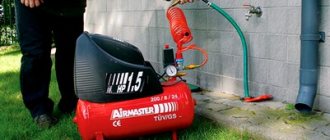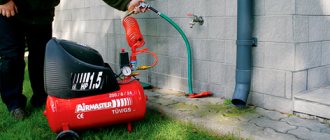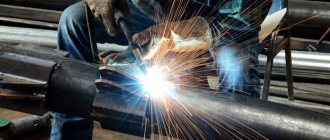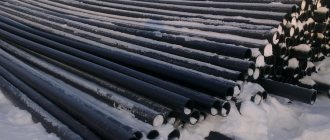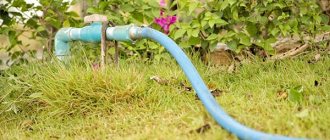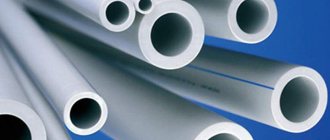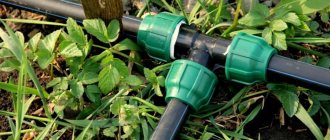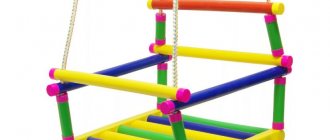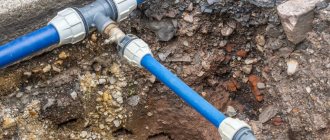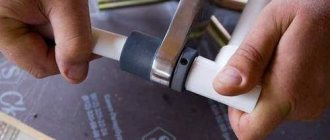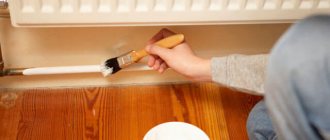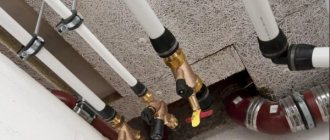Most dachas in Russia are rarely used in winter, since they were originally built for summer holidays and, due to their characteristics (wall materials, insulation), are unsuitable for living at sub-zero temperatures. At this time, most summer residents move back to the city, leaving their country houses without light and heating.
However, before leaving an unheated dacha face to face with frost, it is necessary to carry out a number of preparatory measures, because the water in the pipeline can simply freeze. If you do not prepare the water supply system for frost, then in the spring you may be in for a surprise, because frozen water during a new start-up can severely damage the pipeline.
That is why it is so important to remove all water from the pipeline, irrigation systems, pumps, etc. before winter at the dacha. In this article we will tell you in detail about how to properly preserve the water supply in the country.
Why blow out water pipes before frost?
The main problem of all country water pipes is freezing of water at subzero temperatures. Such a decrease in temperature negatively affects not only the pipeline, but also other equipment. An air compressor can help avoid such consequences; it can be used to clear water from the pipeline so that it does not freeze in it in winter.
This process removes water from:
- Water pipelines unprotected from frost (usually they run between nearby buildings);
- Automatic watering systems;
- Drinkers for animals operating in automatic mode;
- Structures for supplying water to swimming pools.
During the purging process, you need to understand that a pressure of more than 10 atmospheres cannot be supplied to the country pipeline. Otherwise, the pipeline may rupture or leaks will appear over time.
Tool care or how to extend service life
The simplicity of the design does not mean that the device does not require maintenance. To extend the service life of the equipment, it is necessary not only to treat it with care during operation, but also to ensure proper storage and maintenance. We will find out below what the care of a blow gun includes, as well as ways to extend its service life.
- It is necessary to regularly apply lubricant to the valve area to open the air supply. To do this, it is not at all necessary to unscrew the fitting to add lubricant. It is necessary to make a few drops of motor oil (preferably not waste oil), and then develop it by pressing the trigger
- Do not store the instrument in rooms with high humidity, otherwise the formation of oxides and corrosion is possible, not only outside, but also inside the device
- Lubricate not only the valve, but also the threaded connections
- It is also recommended to treat the inner walls of the tips with lubricants, since over time oxides accumulate in them, due to which the throughput opening of the nozzle is reduced. To avoid reducing the diameter of the hole, you should periodically lubricate the internal walls, but not before work, but after it is completed.
Only with proper storage and use will any tool last a long time.
Preparing the country water supply for winter
The process of preparing a pipeline at the dacha itself is simple. However, it is important to do all the steps in a certain order, otherwise you may make mistakes and not drain all the remaining water.
First of all, prepare buckets and other containers before starting work. Blowing with a compressor is carried out as follows:
- Turn off the water completely and then drain the system. At this stage, some of the water will flow out of the pipes by gravity, and the rest will have to be blown out;
- Disconnect other pipeline branches from the central one, so you can isolate them for further purging. Don't forget to install plugs, otherwise a lot of water will spill out;
- Connect the inlet pipe to part of the pipeline, and then plug in the air compressor. When the water stops flowing, the water cleaning is complete and you can turn off the air blower;
- Additionally, the pipes should be mechanically cleaned to remove accumulated deposits (usually minerals and salts).
It is better to carry out the preparatory work on purging the pipeline with a partner, so you can do it faster.
What equipment is needed to blow out pipes?
Plumbing compressors come in a variety of varieties, and their use is not limited to purging pipelines. Below we will tell you in detail about existing compressors, and then you can make the right choice.
Scroll compressors
These devices are primarily characterized by their high reliability and long service life. They are so called because the main element of the installation is a special spiral, which is perfectly balanced, so vibrations are practically not felt during operation.
There are few moving elements in the installation of a scroll compressor, so no extraneous pulsations are observed when the pressure increases. This compressor differs from the piston compressor in its increased volume.
Diaphragm compressors
In such devices, air compression occurs under the influence of a membrane. In this installation, it performs a reciprocating motion, and thus performs the same functions as a piston.
Diaphragm compressors differ:
- stable long-term work;
- long service life;
- ease of use;
- corrosion resistance;
- safety to use.
Inside such a compressor there is a dense rubber chamber; it plays the role of the main air storage device. Therefore, a membrane-type compressor does not rust, which is why it lasts much longer.
Piston compressors
The operating principle of this compressor can be compared to the combustion chamber of an engine in a car. After all, air is also compressed here as in cylinders. Although the design of a piston compressor is quite simple, therefore these models are inexpensive and anyone can purchase them.
Negative aspects of the unit: short operation, high noise level.
Screw compressors
A pressure screw is installed in the design of this device. Almost all models are sheathed on the outside with sound-insulating material, so screw compressors operate almost silently.
The screw compressor needs to be lubricated once every 3 months, but this is only in case of active use. It is this feature that makes this compressor an indispensable assistant in the country when blowing pipes.
Types of pneumatic blow guns
The device in question is classified depending on the purposes and tasks for which it is used. Air guns are divided into types according to the following factors:
- The body material from which the device is made. Manufacturers produce pistols whose bodies are made of metal (often an aluminum alloy) and mineral ceramics. Mineral ceramics feel like plastic. Metal and ceramic devices differ in price. A blow gun with a body made of mineral ceramics is more expensive than its metal counterpart
- The pressure that the device is designed to work with. The air flow also depends on the pressure.
- Functionality - depends on the configuration of the blow gun kit
- The method of connection to the compressor - the difference lies not only in the different sizes of the diameters of the fittings for connecting the hoses. There are guns that, instead of a fitting, have a hole (recess) for connecting a hose
In addition, pneumatic blow guns are classified into types according to the design of the body:
- Pistol - common models of devices that have a body design reminiscent of a firearm. This type is considered more convenient and versatile to use.
- Direct - a simplified version of devices that perform a similar function. They are less convenient to use, but at the same time they can be used to reach hard-to-reach places. The device differs from the pistol type in the absence of a handle. The trigger for opening the valve is located mainly in the upper part of the body, and when using such devices you need to get used to its location in the hand
The cost of direct units for blowing with compressed air is not much different from the price of pistol units. It only makes sense to buy them for your home if you need to reach remote or hard-to-reach places.
What are the pros and cons of using a compressor to blow out pipes?
Any devices used by humans have advantages and disadvantages, compressors are no exception. The positive aspects of using a compressor for blowing pipes include:
- Affordable price. In any city you can purchase inexpensive piston and screw compressors. Some services also sell used equipment. Such services include Yula and Avito. If you decide to buy a used compressor, be sure to pay attention to the accumulator, as they may be rusty;
- High performance . Many models have a coaxial drive, so you can increase the operating speed several times;
- Mobility . Small compressors are easy to maintain and use, as they can be easily dragged from place to place;
- Unpretentiousness . All compressors are already filled with the required amount of lubricant at the factory, so there is no need for constant maintenance.
The disadvantages of using compressors to blow out pipes in a dacha include the likelihood of leaks in the future. This is due to the fact that some pipeline branches are often long. Therefore, it is necessary to create high pressure in the pipeline to expel water, otherwise some connections may begin to leak water in the spring.
Important! Conventional household compressors cannot be used for purging water pipes, as they are not designed for this purpose. In this case, the water supply system of the dacha will not be completely cleaned, and there is a high probability that water will remain in it. Only powerful specialized compressors can create the necessary pressure in order to completely remove water from the pipes.
Choosing the right blow guns
If you plan to buy a pneumatic gun for blowing with compressed air and use it for many years, then you need to choose models that are not cheap. When buying a gun for a compressor whose body is made of steel, you need to take into account one main factor - the tendency to corrode. To protect the steel case, paints and varnishes are used to paint the case. When using the device in conditions of high humidity, as well as when storing it improperly, oxides and rust occur.
Even on steel devices, the dimensions of the nozzle change due to the formation of a corrosion layer. To eliminate such negative consequences, it is recommended to buy a blow-off gun for the compressor, the body of which is made of mineral ceramics. They are durable, have less weight, but are inferior to steel units in terms of strength. In addition to the body material of the blow guns, the following factors must be taken into account when purchasing them:
- The limit value of compressed air consumption, which is measured in liters per minute. This value is also an indicator of productivity, and the more liters per minute a gun can push through the nozzle, the higher its efficiency. It is also worth considering that the rate of emptying of the compressor receiver depends on the flow rate. This means that the unit will need to be turned on more often to pump in a new portion of air. Air consumption also affects the quality of work; the lower the value, the worse the tool copes with the task.
- Pressure - its value usually varies from 2 to 8 atmospheres. For domestic needs, conventional compressed air guns, which are designed to supply pressure in the range from 2 to 4 atmospheres, are sufficient. The production uses reinforced models of pneumatic blow guns
- Connecting hose diameter. There are models of guns that are equipped not only with nozzles, but also come with a high-pressure hose. It is not rational to buy such a kit, since the hose for the blow gun can be purchased separately, choosing the required length and material of manufacture. Depending on the throughput and size of the connecting fitting, it is necessary to take into account the diameter of the connecting hose, the size of which can vary from 6 to 10 mm
- Weight - the simplicity of the device’s design does not make it heavy, but if you compare mineral ceramics and steel products, steel will be heavier. Devices made of aluminum are considered a Chinese or basement counterfeit, and their service life is 3-5 times less than their high-quality counterparts. The weight of the device affects the ease of use. If you use the tool for a short time, then the likelihood of feeling tired is excluded, but with prolonged manipulations, when large volumes have to be blown, weight plays an important role. The weight of the devices is from 0.20 to 0.40 kg, but also take into account the weight of the connected hose
These are the main indicators that you need to consider before choosing a blow gun for your compressor. It is also necessary to take into account the configuration of the device, as well as the manufacturer and its cost. Pistols are produced by manufacturers of domestic, Chinese and European origin. It is impossible to say that Europe produces the best models, since domestic ones are practically no inferior, but at the same time they cost almost 2 times cheaper. Models made in China are no less high quality, but when choosing them you should give preference to well-known companies, such as Intertool, Mastertool, Hausetools and others.
The price shows how high quality the product is. However, you should not overpay for a company when domestic analogues are no worse, but at the same time they cost 1.5-2 times less. It is worth considering that such devices are non-separable and therefore cannot be repaired. However, these devices do not require repair, which is due to the simplicity of their design. If necessary, you can unscrew the nut securing the trigger pusher, which is connected to the air supply valve. If they fail, this valve can be replaced independently.
Below is a useful video for those who are just buying a pneumatic blow gun, but have not had time to get acquainted with its functionality. The video reveals the full potential of the instrument.
Methods for blowing pipes in a country house without a compressor
If you don’t have a powerful compressor, you can easily make one yourself. For this purpose you will need a minimum amount of necessary equipment and additional things:
- Durable polypropylene or Teflon canister;
- Drill;
- Step drill;
- FUM tape;
- Unnecessary bicycle or car camera;
- A pressure gauge for checking tire pressure (costs no more than 100 rubles in car and bicycle stores);
- Ball valve (required to shut off the air supply);
- Several flexible hoses for water supply;
- Fittings with threaded connections for connection to the canister.
The process of creating a simple compressor for blowing pipes
- Drill three holes in the side of the canister. Their diameter should be slightly larger than the fittings;
- Insert the fittings into the canister, make gaskets from the old chamber. And then tighten them securely with the bolts;
- To one fitting you need to connect a simple foot pump for inflating wheels or a small car compressor;
- Connect the hose securely to the second fitting, then screw in the ball valve, and then again the flexible connection. Do not forget to seal all connections with FUM tape;
- A pressure gauge is screwed into the third fitting to monitor the pressure in the canister.
Draining water through the drain hole
A very simple and therefore popular method: you need to drill a hole in a pipe or hose between the freezing point and the static water level. The diameter should be small, 1-3 mm, you can make a hole with an awl, drill or nail.
Such a small hole does not affect the operation of the pumping system, but the water gradually pours out, which is what is needed.
Cons: cannot be installed on systems with automation and hydraulic accumulators. Water will have time to pour out during pauses between injections, air will begin to enter the system, resulting in breakdowns.
So the method is simple, but it also works with the same simple systems.
How to blow out pipes in a dacha using a compressor?
- Connect the flexible line from the canister to the vented part of the pipeline (do not forget to remove one plug or open the tap before doing this, since the water will need to come out somewhere);
- Close the ball valve;
- Pump up pressure into the canister with a compressor (this is done with a manual or electric compressor);
- Then it is necessary to increase the pressure in the canister to 4-5 atmospheres;
- After this, you need to stop pumping air into the canister;
- Now you need to gradually open the tap, and the air pressure will displace all the water from the system being purged.
We organize water drainage through a special valve
The previous solution is quite expensive. Cost of the crane, cost of excavation and drainage installation. For a more budget-friendly solution, you can use a special valve with the function of draining water after stopping use of the well. This valve is placed on the water-lifting column in its upper part.
The operation of this valve is as follows:
- Turning on the pump and creating pressure in the pipelines;
- Water use;
- Switching off the pump;
- Draining excess pressure and remaining water through the tap;
- The valve operates and water drains into the well.
As a result, all pipelines are freed from water and freezing of the system is eliminated.
Stages of preservation of home water supply
Next, we will talk about the procedure for preserving the water supply system at the dacha for the winter. The whole process is done in several stages:
- Turn off the water at the entrance to the house;
- Open all plugs in the home branch of the pipeline;
- Prepare cans, rags and containers. Since water can escape from all open parts of the pipeline;
- Connect the compressor to the vented part of the pipeline;
- Turn on the compressor; when air comes out, it means the water supply system is preserved and therefore will not be damaged by frost.
Stages of conservation of street water supply and automatic watering systems
Street water supply in dachas is often located above the ground or at a depth of up to 0.5 m. Therefore, such systems must be emptied before winter frosts, otherwise the resulting ice will break all the pipes.
It is especially important to blow out all metal pipes, since threaded connections quickly burst in the cold. PVC pipes are not so afraid of frost, but the water still needs to be removed from them; a compressor will also do an excellent job with this task.
Do not forget to remove water from storage tanks for irrigation, outdoor showers and other containers. All ball valves must be left open, then they will easily survive the winter and can be used in the future.
Stages of conservation of wells and wells
In addition to preserving pipes in the country, it is also important to take care of preparing water sources for frost. Below we will tell you how to do it correctly.
Well
The water in the wells always has a positive temperature, so it does not need special conservation. If the well is shallow (up to 4 meters), then it is recommended to make a heat-insulating cover that will protect the well from freezing. It can be made from sheets of polystyrene foam or penoplex.
Well
Preservation of a well for the winter is done in several stages:
- First of all, remove all equipment from the well (they need to be stored in a heated room);
- Then you should blow out the pipes that go into the house;
- After checking the casing, you can fill it with a neutral composition (crushed stone with fine sand is perfect for this purpose);
- An antifreeze liquid must be applied to the top of the structure.
How to modify a blow gun
It often becomes necessary to use blowing equipment with an extended nozzle. However, if the gun was purchased without a set of nozzles, then to achieve this goal you will either need to buy tips in a set, or there is an easier way - to make a nozzle with an extended nozzle with your own hands. Let's look at how to do this using improvised means below. What you will need to make a nozzle for a blow gun for a compressor:
- Steel tube from the brake system of any car. In this case, it is not at all necessary to buy a new tube, since if such a part is not lying around in the garage, then it can be bought at a car dismantling site. Moreover, not the entire tube is required, but only some part of it, but always with an end nut
- Tool for rolling a tube. The part of the tube that will connect to the gun nozzle is rolled. Rolling is needed in order to eliminate loss of compressed air pressure at the junction of the homemade nozzle
- Key "10" for tightening the tube onto the nozzle of the blow gun
- A grinder for cutting the tube needs length
When all the necessary components are assembled, all that remains is to make a homemade nozzle with an extension cord. The manufacturing instructions look like this:
- Using a grinder, the required size of the tube is cut off - usually its length is up to 10-15 cm. You need to cut with a grinder, since using metal scissors or pliers will deform the tube
- The reverse side of the tube is rolled where it will connect to the gun
- The finished nozzle is screwed into the device nozzle using a nut with an external thread.
- You need to tighten it with a wrench to prevent a loose connection.
- Test the work of homemade products
A do-it-yourself nozzle for a blow gun is practically no different from factory models, but it will cost practically nothing, and you will have to spend about 150-200 rubles to buy a set of factory tips, which depends on the manufacturer.
A detailed description of how to modify or make a tip with an extended nozzle is described in the video.
